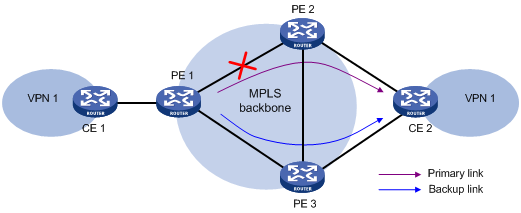
Shared Risk Link Group (SRLG)-disjoint: Eliminates LFAs that belong to any of the protected path SRLGs. Path metric may remain in the routing table after this tie-breaker is applied. Lowest-repair-path-metric: Eliminates LFAs whose metric to the protected prefix is high. Linecard-disjoint: Eliminates LFAs that share the line card with the protected path. Interface-disjoint: Eliminates LFAs that share the outgoing interface with the protected path. The following four attributes to implement tie-breaking rules: A tie-breaking rule considers LFAs that satisfy certain conditions or have certain attributes.

When there are multiple candidate LFAs for a given primary path, EIGRP uses a tie-breaking rule to select one LFA per primary Per-link computations because per-prefix computations evaluate all possible LFAs and use tie-breakers to select the best LFA Per-prefix computations provide better load sharing and better protection coverage than The per-prefix approach is preferred over the per-link approach because of its greater applicabilityĪnd better bandwidth utilization. Per-prefix (prefix-based) computation: Prefix-based LFAs allow computing backup information per prefix (network) and protect RedirectingĪll traffic to the next hop may lead to congestion on the link to the next hop. Therefore, the per-link approach is suboptimal and not the best approach for capacity planningīecause all traffic from the primary link is redirected to the next hop instead of being spread over multiple paths. The per-link approach protects only the next-hop address. Repair or the Fast Reroute (FRR) ability. This means that the whole set of prefixes sharing the primary link also share the Per-link (link-based) computation: In link-based LFAs, all prefixes (networks) that are reachable through the primary (protected) Interior Gateway Protocols (IGPs) compute LFAs in the following two ways: To an LFA after a network failure and the LFA makes the forwarding decision without any knowledge of the failure. Precomputed repair paths or backup routes are known as feasible successors or LFAs.Ī LFA is a precomputed next-hop route that delivers a packet to its destination without looping back. Paths in anticipation of failures so that the repair paths can be activated the moment a failure is detected. Their forwarding data and the failed link is eliminated from the routing computation. By the time the routing transition is complete, all devices in the network revise Until the routing transition is complete. These repair paths are used from the time the router detects the failure Paths for packets that would have used the failed link. A device adjacent to the failed link employs a set of repair Meanwhile, packets affectedīy the network failure need to be steered to their destinations. The propagation of this information may take several hundred milliseconds. Network are unaware of the nature and location of this failure until information about this failure is propagated through When a link or a device fails, initially only the neighboring devices are aware of the failure. Of the network, the connectivity between the source and destination pairs of devices is interrupted. Until the transition is complete and all devices are converged on a common view The time taken for thisĬomputation is called routing transition. When a link or a device fails, distributed routing algorithms compute new routes or repair paths. Restrictions for EIGRP Loop-Free Alternate IP Fast Reroute Feature Information for EIGRP Loop-Free Alternate IP Fast Reroute.Configuration Examples for EIGRP Loop-Free Alternate IP Fast Reroute.
EIGRP IP FAST REROUTE HOW TO
How to Configure EIGRP Loop-Free Alternate IP Fast Reroute.



 0 kommentar(er)
0 kommentar(er)
